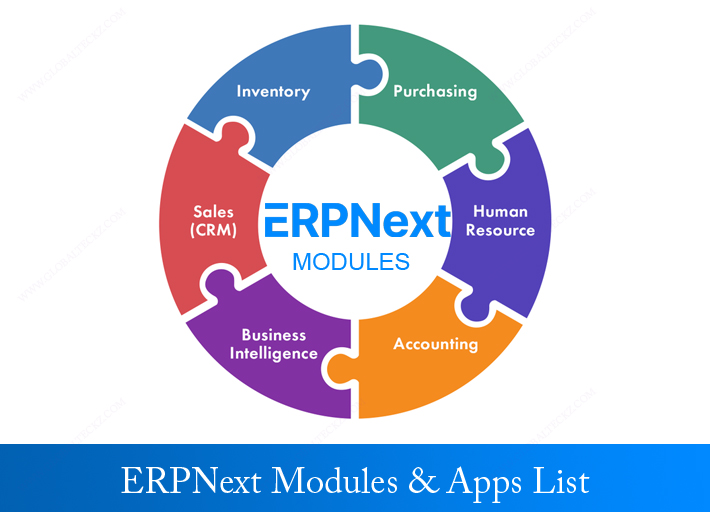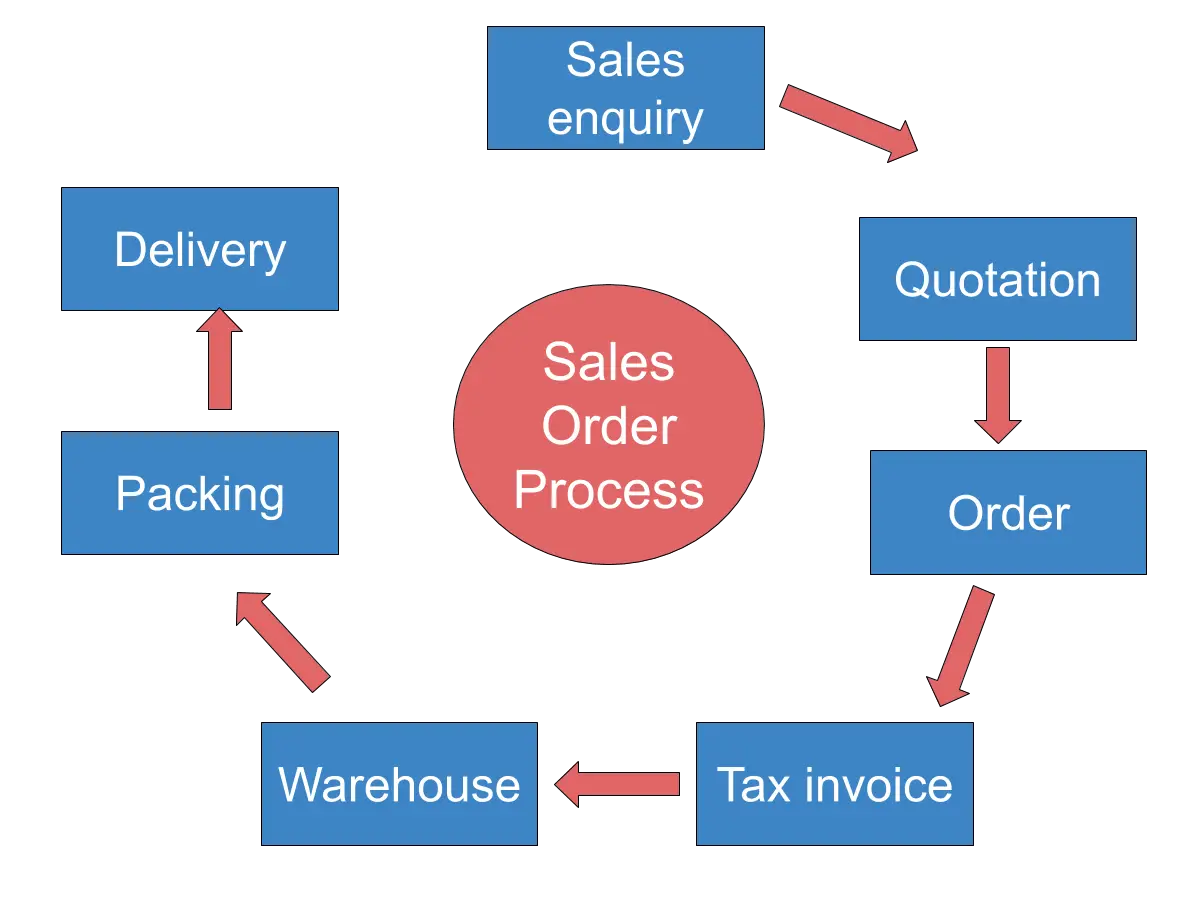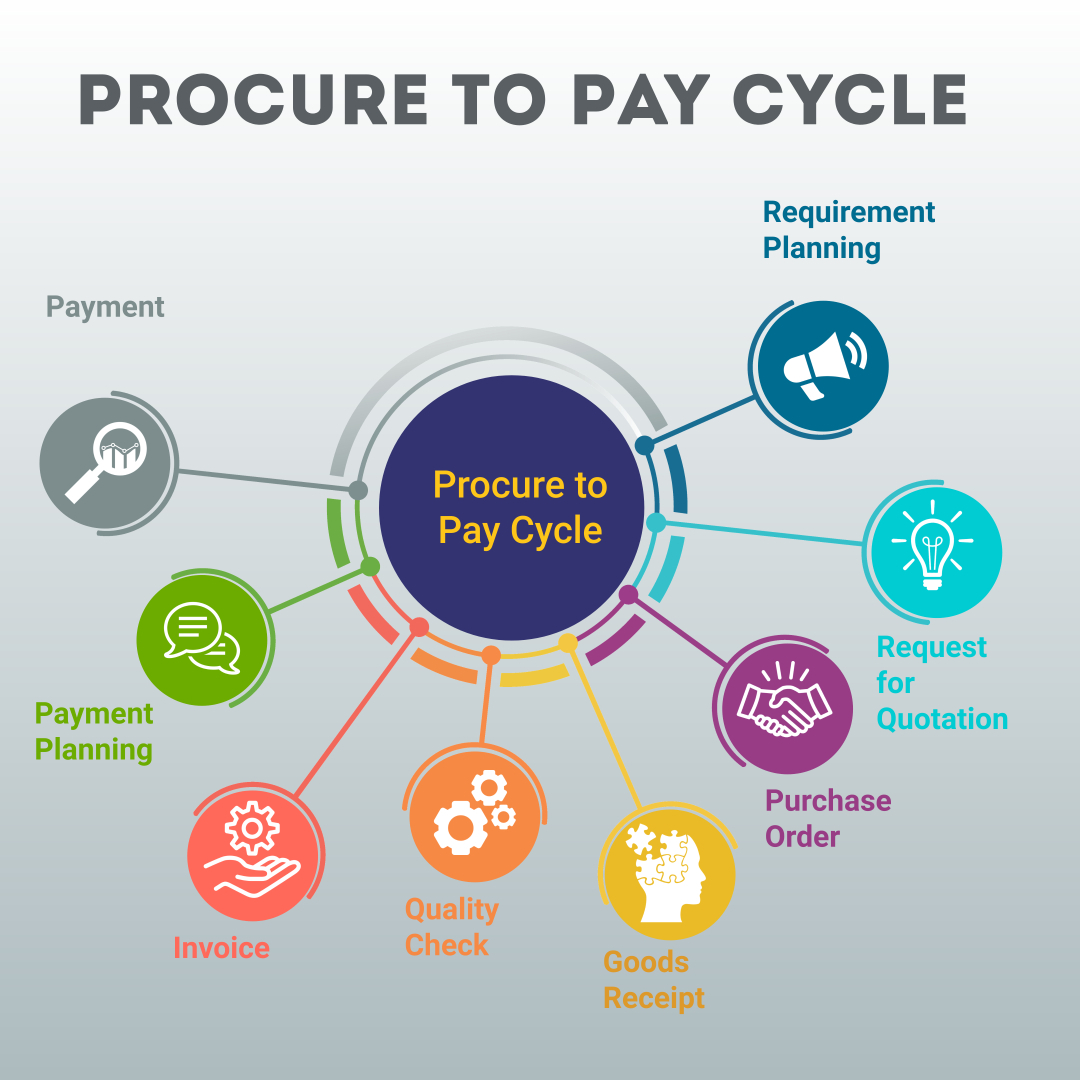All you want to know about ERPNext

Order to Cash Cycle
ERPNext's Sales module encompasses a variety of features to help businesses manage their sales processes effectively. Here are the key components of the Sales module in ERPNext:
Quotation Management:
Create and manage sales quotations with details of products, pricing, and terms.
Convert quotations into sales orders with a single click.
Sales Order Management:
Quotation Management:
Create and manage sales quotations with details of products, pricing, and terms.
Convert quotations into sales orders with a single click.Sales Order Management:
Generate sales orders from quotations or directly.
Track customer orders, order statuses, and expected delivery dates.
Customer Management:
Maintain a database of customer information, including contact details, billing and shipping addresses, and payment terms.
Item Catalog:
Manage a comprehensive list of products or services that your business offers.
Includes details like item codes, descriptions, prices, and units of measurement.
Pricing and Discount Management:
Define pricing structures and discount schemes for different customers or products.
Automatically apply discounts based on predefined rules.
Sales Invoice Generation:
Generate sales invoices based on sales orders or deliveries.
Include details of items sold, quantities, prices, taxes, and other relevant charges.
Delivery Note and Shipment:
Manage the process of preparing and confirming deliveries to customers.
Create delivery notes to track products shipped to customers.
Sales Returns and Refunds:
Record and manage returns from customers.
Process refunds or replacements as required.
Payment Management:
Record customer payments and link them to sales invoices.
Track outstanding payments and monitor customer balances.
Sales Analytics and Reports:
Access reports and analytics on sales performance, revenue, top-selling items, and customer trends.
Commission Tracking:
Calculate and track sales commissions for salespeople based on predefined rules.
Integration with Other Modules:
The Sales module integrates with other ERPNext modules, such as Inventory, Accounting, and CRM, ensuring seamless data flow and accuracy.
Multi-Currency Support:
Handle sales transactions in different currencies, allowing you to conduct business globally.
Maintain a database of customer information, including contact details, billing and shipping addresses, and payment terms.
Item Catalog:
Manage a comprehensive list of products or services that your business offers.
Includes details like item codes, descriptions, prices, and units of measurement.
Pricing and Discount Management:
Define pricing structures and discount schemes for different customers or products.
Automatically apply discounts based on predefined rules.
Sales Invoice Generation:
Generate sales invoices based on sales orders or deliveries.
Include details of items sold, quantities, prices, taxes, and other relevant charges.
Delivery Note and Shipment:
Manage the process of preparing and confirming deliveries to customers.
Create delivery notes to track products shipped to customers.
Sales Returns and Refunds:
Record and manage returns from customers.
Process refunds or replacements as required.
Payment Management:
Record customer payments and link them to sales invoices.
Track outstanding payments and monitor customer balances.
Sales Analytics and Reports:
Access reports and analytics on sales performance, revenue, top-selling items, and customer trends.
Commission Tracking:
Calculate and track sales commissions for salespeople based on predefined rules.
Integration with Other Modules:
The Sales module integrates with other ERPNext modules, such as Inventory, Accounting, and CRM, ensuring seamless data flow and accuracy.
Multi-Currency Support:
Handle sales transactions in different currencies, allowing you to conduct business globally.
Define pricing structures and discount schemes for different customers or products. Automatically apply discounts based on predefined rules.
Sales Invoice Generation:
Generate sales invoices based on sales orders or deliveries.
Include details of items sold, quantities, prices, taxes, and other relevant charges.
Delivery Note and Shipment:
Manage the process of preparing and confirming deliveries to customers.
Create delivery notes to track products shipped to customers.
Sales Returns and Refunds:
Record and manage returns from customers.
Process refunds or replacements as required.
Payment Management:
Record customer payments and link them to sales invoices.
Track outstanding payments and monitor customer balances.
Sales Analytics and Reports:
Access reports and analytics on sales performance, revenue, top-selling items, and customer trends.
Commission Tracking:
Calculate and track sales commissions for salespeople based on predefined rules.
Integration with Other Modules:
The Sales module integrates with other ERPNext modules, such as Inventory, Accounting, and CRM, ensuring seamless data flow and accuracy.
Multi-Currency Support:
Handle sales transactions in different currencies, allowing you to conduct business globally.
Manage the process of preparing and confirming deliveries to customers. Create delivery notes to track products shipped to customers.
Sales Returns and Refunds:
Record and manage returns from customers.
Process refunds or replacements as required.
Payment Management:
Record customer payments and link them to sales invoices.
Track outstanding payments and monitor customer balances.
Sales Analytics and Reports:
Access reports and analytics on sales performance, revenue, top-selling items, and customer trends.
Commission Tracking:
Calculate and track sales commissions for salespeople based on predefined rules.
Integration with Other Modules:
The Sales module integrates with other ERPNext modules, such as Inventory, Accounting, and CRM, ensuring seamless data flow and accuracy.
Multi-Currency Support:
Handle sales transactions in different currencies, allowing you to conduct business globally.
Record customer payments and link them to sales invoices. Track outstanding payments and monitor customer balances.
Sales Analytics and Reports:
Access reports and analytics on sales performance, revenue, top-selling items, and customer trends.
Commission Tracking:
Calculate and track sales commissions for salespeople based on predefined rules.
Integration with Other Modules:
The Sales module integrates with other ERPNext modules, such as Inventory, Accounting, and CRM, ensuring seamless data flow and accuracy.
Multi-Currency Support:
Handle sales transactions in different currencies, allowing you to conduct business globally.
Calculate and track sales commissions for salespeople based on predefined rules.
Integration with Other Modules:
The Sales module integrates with other ERPNext modules, such as Inventory, Accounting, and CRM, ensuring seamless data flow and accuracy.
Multi-Currency Support:
Handle sales transactions in different currencies, allowing you to conduct business globally.
Handle sales transactions in different currencies, allowing you to conduct business globally.
Procure to Pay Cycle
Key Modules in the Procure-to-Pay Cycle
- Requisition: This module initiates the procurement process by generating a purchase requisition. It involves identifying the need for goods or services and creating a formal request for purchase.
- Purchase Order (PO) Management: Once the requisition is approved, a purchase order is created. This module manages the creation, approval, and distribution of purchase orders to suppliers.
- Supplier Management: This module handles the management of supplier information, such as contact details, terms, and performance metrics. It ensures accurate supplier records and enables effective communication.
- Purchase Quotation, Vendor Selection and Evaluation: Request for Quotation & Quotation Evaluation.
- Purchase Order & Tracking: Purchase Order confirmation, shipment tracking, and delivery notifications.
- Purchase Receipt and Inspection: Manages the receiving of goods and services, including inspection and verification against purchase orders. This module may include quality control and acceptance processes.
- Inventory Management: Tracks and manages inventory levels after goods are received, ensuring accurate stock levels and timely replenishment.
- Invoice Processing: Handles the receipt, validation, and approval of supplier invoices. This module may include matching invoices to purchase orders and goods receipts.
- Accounts Payable: Manages the financial aspect of the procurement process, including recording supplier invoices, tracking payment terms, and processing payments to suppliers.
- Approval Workflows: Manages the approval process for purchase requisitions, purchase orders, and supplier invoices. It ensures proper authorization at various stages.
- Reporting and Analytics: Provides insights into procurement performance, spending patterns, supplier performance, and other key metrics.
- Document Management: Organizes and stores documents related to procurement, such as contracts, purchase orders, and supplier correspondence.
The Procure-to-Pay cycle involves a series of interrelated modules that work together to ensure efficient and compliant procurement processes, from requisition to payment. These modules contribute to streamlining operations, improving supplier relationships, and optimizing costs.
Manufacturing Modules
Manufacturing Features in ERPNext
- Bill of Materials (BOM) Management: Create and manage BOMs that define the structure of a product, including raw materials, components, and subassemblies needed for production.
- Routing and Workstation Management: Define production routes and workstations for each manufacturing process step, ensuring efficient workflow management.
- Production Orders: Generate production orders to initiate the manufacturing process. Monitor and track the progress of each order through different production stages.
- Material Requirements Planning (MRP): Use MRP to automatically calculate the materials needed for production based on demand, existing inventory, and lead times.
- Job Cards: Create job cards for each production order, detailing the specific tasks and instructions for the shop floor workers.
- Work in Progress (WIP) Tracking: Monitor work in progress at different production stages, allowing better visibility into production status.
- Quality Control: Implement quality control checks and define quality inspection criteria at different production stages to ensure product quality.
- Batch and Serial Number Tracking: Track products using batch or serial numbers, providing traceability for quality control and compliance.
- Capacity Planning: Manage production capacity by analyzing resource availability and scheduling production orders accordingly.
- Shop Floor Control: Assign and track production tasks to specific workstations, enabling real-time monitoring and control of manufacturing operations.
- Subcontracting: Manage subcontracting processes by creating purchase orders for services required in the production process.
- Multi-Level Production: Handle complex production scenarios involving multi-level assemblies and subassemblies.
- Material Issue and Consumption: Record and track the consumption of raw materials and components during the production process.
- Product Lifecycle Management (PLM): Manage the entire lifecycle of a product, from design and development to production and obsolescence.
- Machine and Equipment Management: Maintain records of machines and equipment used in production, track maintenance schedules, and monitor their utilization.
- Work Order Scheduling: Schedule production orders based on resource availability, lead times, and production priorities.
- Resource Allocation: Allocate resources, including labor, machines, and materials, to different production tasks.
- Production Analytics and Reporting: Access detailed reports and analytics on production efficiency, costs, lead times, and resource utilization.
- Integration with Inventory and Sales: Seamlessly link manufacturing with inventory management and sales processes to ensure accurate stock levels and timely order fulfillment.
- Traceability and Recall Management: Enable product traceability to facilitate recalls and investigations if quality or safety issues arise.



